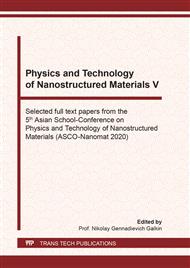[1]
D. Zhang, B. Gökce, S. Barcikowski, Laser synthesis and processing of colloids: fundamentals and applications, Chem. Rev. 117 (2017) 3990-4103.
DOI: 10.1021/acs.chemrev.6b00468
Google Scholar
[2]
M.B. Gongalsky, L.A. Osminkina, A. Pereira, et al., Laser-synthesized oxide-passivated bright Si quantum dots for bioimaging, Sci. Rep. 6 (2016) 24732.
DOI: 10.1038/srep24732
Google Scholar
[3]
D. Rioux, M. Laferriere, A. Douplik, et al., Silicon nanoparticles produced by femtosecond laser ablation in water as novel contamination-free photosensitizers, J. Biomed. Opt. 142 (2009) 021010.
DOI: 10.1117/1.3086608
Google Scholar
[4]
S.V. Zabotnov, F.V. Kashaev, D.V. Shuleiko, et al., Silicon nanoparticles as contrast agents in the methods of optical biomedical diagnostics, Quantum Electron. 47 (2017) 638-646.
DOI: 10.1070/qel16380
Google Scholar
[5]
A. Al-Kattan, V.P. Nirwan, A. Popov, et al., Recent advances in laser-ablative synthesis of bare Au and Si nanoparticles and assessment of their prospects for tissue engineering applications, Int. J. Mol. Sci. 19 (2018) 1563.
DOI: 10.3390/ijms19061563
Google Scholar
[6]
O.I. Ksenofontova, A.V. Vasin, V.V. Egorov, et al., Porous silicon and its applications in biology and medicine, Tech. Phys. 59 (2014) 66-77.
Google Scholar
[7]
J.-H. Park, L. Gu, G. von Maltzahn, et al., Biodegradable luminescent porous silicon nanoparticles for in vivo applications, Nat. Mater. 8 (2009) 331-336.
DOI: 10.1038/nmat2398
Google Scholar
[8]
P.A. Perminov, I.O. Dzhun, A.A. Ezhov, et al., Creation of silicon nanocrystals using the laser ablation in liquid, Las. Phys. 21 (2011) 801-804.
DOI: 10.1134/s1054660x11080020
Google Scholar
[9]
S.V. Zabotnov, D.A. Kurakina, F.V. Kashaev, et al., Structural and optical properties of nanoparticles formed by laser ablation of porous silicon in liquids: Perspectives in biophotonics, Quantum Electron. 50 (2020) 69-75.
DOI: 10.1070/qel17208
Google Scholar
[10]
V.A. Sivakov, G. Brönstrup, B. Pecz, et al., Realization of vertical and zigzag single crystalline silicon nanowire architectures, J. Phys. Chem. C 114 (2010) 3798-3803.
DOI: 10.1021/jp909946x
Google Scholar
[11]
I.N. Saraeva, S.I. Kudryashov, A.A. Rudenko, et al., Effect of fs/ps laser pulsewidth on ablation of metals and silicon in air and liquids, and on their nanoparticle yields, Appl. Surf. Sci. 470 (2019) 1018-1034.
DOI: 10.1016/j.apsusc.2018.11.199
Google Scholar
[12]
L.A. Osminkina, V.A. Sivakov, G.A. Mysov, et al., Nanoparticles prepared from porous silicon nanowires for bio-imaging and sonodynamic therapy, Nanoscale Res. Lett. 9 (2014) 463.
DOI: 10.1186/1556-276x-9-463
Google Scholar
[13]
S.V. Zabotnov, M.M. Kholodov, V.A. Georgobiani, et al., Photon lifetime correlated increase of Raman scattering and third-harmonic generation in silicon nanowire arrays, Las. Phys. Lett. 13 (2016) 035902.
DOI: 10.1088/1612-2011/13/3/035902
Google Scholar
[14]
H. Gebavi, D. Ristić, N. Baran, et al., Silicon nanowires as sensory material for surface-enhanced Raman spectroscopy, Silicon 11 (2019) 1151-1157.
DOI: 10.1007/s12633-018-9906-0
Google Scholar
[15]
R. Ghosh, P.K. Giri, K. Imakita and M. Fujii, Origin of visible and near-infrared photoluminescence from chemically etched Si nanowires decorated with arbitrarily shaped Si nanocrystals, Nanotechnology 25 (2014) 045703.
DOI: 10.1088/0957-4484/25/4/045703
Google Scholar
[16]
R.-P. Wang, G.-W. Zhou, Y.-L. Liu, et al., Raman spectral study of silicon nanowires: High-order scattering and phonon confinement effects, Phys. Rev. B 61 (2000) 16827-16832.
DOI: 10.1103/physrevb.61.16827
Google Scholar
[17]
S.V. Zabotnov, A.V. Kolchin, F.V. Kashaev, et al., Structural analysis of nanoparticles formed via laser ablation of porous silicon and silicon microparticles in water, Tech. Phys. Lett. 45 (2019) 1085-1088.
DOI: 10.1134/s1063785019110142
Google Scholar


